
The Loring Residence and Clinic was the first facility built to provide medical services to Valparaiso, Indiana. The residence has continued to provide for public service through its current use by the Valparaiso Woman's Club. Dr. Loring used his home as his medical office until his death in 1914. It was Loring's initial efforts that brought medical care to the county and provided for the first hospital. Although private, it became the county's first public hospital when Loring sold the building in 1906 to build his home and clinic.

The Jefferson–Chalmers Historic Business District is a neighborhood located on East Jefferson Avenue between Eastlawn Street and Alter Road in Detroit, Michigan. The district is the only continuously intact commercial district remaining along East Jefferson Avenue, and was listed on the National Register of Historic Places in 2004.

The Chesterton Commercial Historic District is a historic district in Chesterton, Indiana.

The Harlow Block is a commercial building located at 100 West Washington Street in Marquette, Michigan. It was listed on the National Register of Historic Places in 1983.

The National Building is a historic warehouse building in downtown Seattle, Washington, located on the east side of Western Avenue between Spring and Madison Streets in what was historically Seattle's commission district. It is now home to the Seattle Weekly. It is a six-story plus basement brick building that covers the entire half-block. The dark red brick facade is simply decorated with piers capped with small Ionic capitals and a small cornice, which is a reproduction of the original cornice. Kingsley & Anderson of Seattle were the architects.

Jackson Park Town Site Addition Brick Row is a group of three historic houses and two frame garages located on the west side of the 300 block of South Third Street in Lander, Wyoming. Two of the homes were built in 1917, and the third in 1919. The properties were added to the National Register of Historic Places on February 27, 2003.

Fifth Street Historic District is a national historic district located at Lynchburg, Virginia. The district encompasses 57 contributing buildings and 1 contributing object in a historically African-American section of Lynchburg. It includes a variety of residential, commercial, and institutional buildings, with about half dating to the period spanning from 1875 to 1940. Located in the district are the separately listed Kentucky Hotel, the Western Hotel, the William Phaup House, and the Pyramid Motors building. Other notable buildings include the Augustine Leftwich House, tobacco factories (1877-1885), the Humbles Building (1915), M.R. Scott Meat Market (1919), Miller Tire and Battery Company (1927), Adams Motor Company building (1927), Hoskins Pontiac (1951), Burnett Tire Company (1956), Moser Furniture Company building (1936), Fifth Street Baptist Church (1929), Community Funeral Home (1922), and Tal-Fred Apartments (1940).

105 South Washington Street in Huntsville, Alabama, is a historic commercial building. It was built in 1931, after the previous building on the site had burned in 1925. The street level of the two-story brick building has three single-pane windows on either side of a recessed entry. A row of similar windows runs above the street level, separated by a row of rectangular panels. Above the storefront level sits a panel of soldier course bricks, with decorative terra cotta floral blocks on the corners. The same blocks are used on the top corners of the surrounds for five windows above. The frieze is terra cotta, with a series of narrow flutes above a decorative bed-mould chain. The cornice features a geometric X-pattern with small dentils on each block. The terra cotta detailing exhibits Art Deco influence, popular at the time the building was constructed. The building was listed on the National Register of Historic Places in 1984.
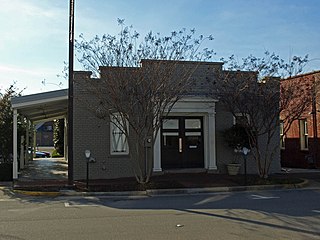
The Halsey Grocery Warehouse is a historic warehouse in Huntsville, Alabama. It was built in 1923 as a second grocery warehouse for the W. L. Halsey company. The one-story building is simple in design, especially when compared with the company's earlier building across the street. The façade is of grey painted brick with a stepped parapet. The central double entrance door is flanked by single windows, each of which is topped with a brick arch. The pilasters and entablature surrounding the door are a later addition; originally, the door was topped only with a rowlock course of brick. The south side has a shed roof covering what was the loading area.

The W. L. Halsey Warehouse is a historic warehouse in Huntsville, Alabama. The two-story brick structure was built in 1904 by the W. L. Halsey grocery company. The façade is divided into six bays by locally produced cast iron columns. Originally, the street level presented a fully glass storefront, but all bays but the doorway have been covered with wood panels. Windows on the second floor are one-over-one sashes topped with decorative brick arches; ten similar windows on the side of the building facing Meridian Street have been covered. The cornice has sunburst patterns alternating with triangular brackets. A panel over the center of the cornice reads "W.L. Halsey - 1904".
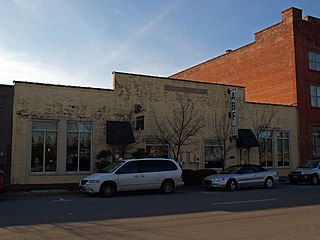
The Kelly Brothers and Rowe Building is a historic warehouse in Huntsville, Alabama. Built in 1928, the façade is nearly free of ornamentation, except for a raised central parapet, with a plaque reading "Kelly Bros. & Rowe", and soldier course brick outlining the building and openings. Originally, the front featured two large warehouse doors, each with an entry door and a multi-pane window towards the center of the building. The warehouse doors have each been replaced with a twin-pane fixed window and transom, and the multi-pane windows have been replaced with a single pane and transom.
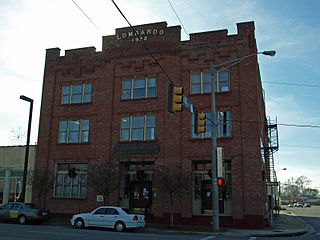
The Lombardo Building is a historic warehouse in Huntsville, Alabama. The three-story brick structure was built in 1922. The façade is divided into three bays by four piers. The center and right bays each have a double entry door with transom and sidelights, while the left bay contains a group of four one-over-one sash windows topped with a transom. Each of the upper floors has groups of three one-over-one windows. Each bay is topped with three decorative corbels, below a stepped parapet. The center of the parapet is marked with "LOMBARDO" and "1922".

The Donegan Block is a historic commercial building in Huntsville, Alabama. Built in 1870, it and the adjacent building, the Rand Building, represent a simplified Italianate architecture style common in smaller towns in the late 19th century. It is one of few remaining Italianate buildings which once were prevalent on Courthouse Square. The 2+1⁄2-story building is divided into four units, each three bays wide. The units are divided on the façade by brick pilasters, which were originally faced with cast iron on the ground floor. The two eastern units are combined, and share an entrance flanked by two multi-paned fixed windows on each side. The other two units have central entrances with one window on each side. The three eastern units are treated similarly, with triangular pediments and pilasters surrounding each door and window. The western unit had been modified with a recessed entry and windows, but these were later returned flush with the building and are topped with fanlights and segmental brick arches. Second floor windows on all four units are tall and narrow with arched tops and roll moldings with keystones. The attic level has short vents treated similarly to the second floor windows. A bracketed and denticulated metal cornice projects from the top of the building. It was listed on the National Register of Historic Places in 1980.
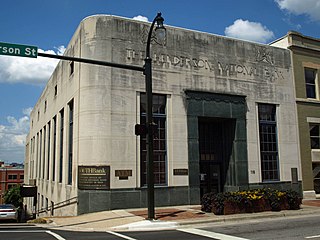
The Henderson National Bank building is a historic bank building in Huntsville, Alabama. One of the only Art Moderne style buildings in Huntsville, the bank was built in 1948. The outer walls are constructed of large blocks of ashlar, while the base and entrance surround on the Jefferson Street façade are lined with dark green stone. The recessed double doors sit below a tall, multi-pane toplight. The entry is flanked by tall, multi-pane windows, giving the façade a much more vertical orientation than the early 20th-century commercial brick style. The upper portion is inscribed with two geometric flower shapes in relief and the name of the bank. The corner wall is rounded, leading to more tall windows along the side. A drive-up teller window was added to the rear of the building in 1958, which is faced with light tan brick.

The W. T. Hutchens Building is a historic commercial building in Huntsville, Alabama, United States. A three-bay building on the corner of Jefferson Street and Clinton Avenue, the two corner bays were built in 1916 and the third built in a nearly identical style in 1921. It was built in the Early Commercial brick style, which departed from highly ornamented, vertically-oriented Victorian styles, instead emphasizing horizontal orientation by using strong horizontal courses and shorter, wider windows. It contrasts with the later Terry Hutchens Building, across Clinton Avenue, which is representative of later, again vertically-oriented Gothic Revival styles.
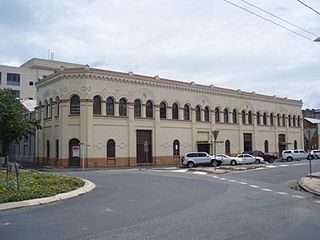
GS Curtis Stores is a heritage-listed warehouse at Bolsover Street, Rockhampton City, Rockhampton, Rockhampton Region, Queensland, Australia. It was designed by John William Wilson and built from 1882 to 1883 by P Waters & Sons. It is also known as AMV Warehouse. It was added to the Queensland Heritage Register on 21 October 1992.

The Spiritual Israel Church and Its Army Temple, originally known as the Amity Lodge No. 335 Temple, is a historic building located at 9375 Amity Street in Detroit, Michigan, on the city's east side. It was listed on the National Register of Historic Places in 2014.

The Weinmann Block is a commercial building located at 219-223 East Washington Street in Ann Arbor, Michigan. It was listed on the National Register of Historic Places in 1983.
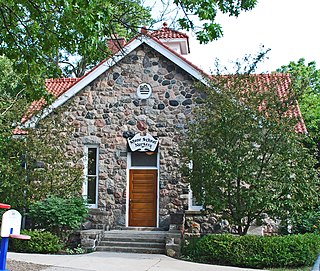
The Stone School is a school building located at 2600 Packard Road in Ann Arbor, Michigan. It was listed on the National Register of Historic Places in 1995. Beginning in 1955, the building houses the Stone School Cooperative Nursery.

The Bulletin Place Warehouses are a series of three heritage-listed former warehouses and now souvenir sales office, commercial offices, health club, storage area, and restaurant located between 6–18 Bulletin Place, in the Sydney central business district in the City of Sydney local government area of New South Wales, Australia. The warehouses were built from 1880 and have variously been known as the San Francisco Restaurant. The property is privately owned. It was added to the New South Wales State Heritage Register on 2 April 1999.

























